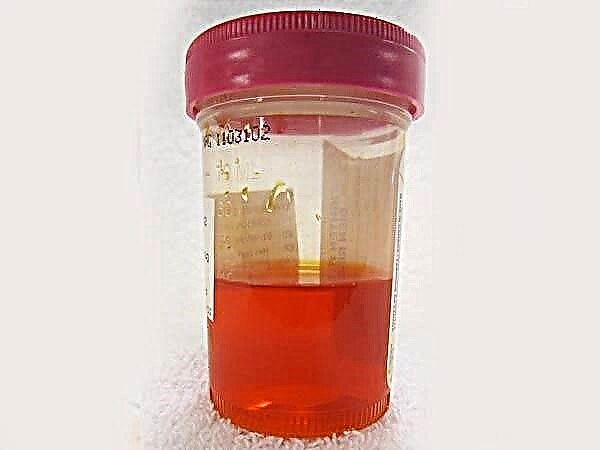Usually, vomiting in young children is very frightening for parents. Doctors reassure, arguing that the presence of vomiting is not always a symptom of the disease. Most often, it helps the body flush out toxins. The situation is much worse when a child vomits blood. This is always a signal for immediate medical attention.

Vomiting with blood in a child is a dangerous symptom that signals problems in the body
Vomiting mechanism
In order not to worry in vain, parents need to understand that the gag reflex is a protective reaction of the body, which receives signals about the need to empty the stomach. Such signals enter the brain, where the center of the gag reflex is located, from different parts of the body: from the vestibular apparatus, from the stomach or intestines. Figuratively speaking, the center gives the command, and the stomach empties.
The emetic process occurs during a strong peristalsis of the stomach and esophagus when the vomiting center is excited. The vomiting impulse has a relaxing effect on the walls of the stomach, in a similar way the muscle ring in the lower esophagus relaxes. There is a contraction of the muscles of the abdominal wall and diaphragm, the contents of the stomach are thrown out through the mouth and nose. In this case, the root of the tongue blocks the airways so that asphyxiation does not occur, that is, suffocation with vomit.
Note. A warning about emetic comes through nausea, involuntary swallowing movements, increased salivation, lacrimation, trembling, cold hands and feet, or, conversely, increased sweating.
Symptoms and signs of bloody vomiting
Parents are most worried about why the child vomits with blood. Bloody vomiting in babies often indicates damage to the stomach walls or rupture of the esophageal lining. This can happen due to mechanical injury or infection. When such a symptom appears, you should immediately seek medical help without self-medication.
Important! Parents should be alerted to the signs of blood-streaked vomiting in the child. Before talking about the reasons for this phenomenon, you need to determine the amount and saturation of blood in the vomit. To tell the pediatrician everything in detail, you need to carefully consider her appearance.
Difference from hemoptysis
Sometimes bloody vomiting is compared to an eversion cough, in which the discharge is colored red. In order not to confuse hemoptysis and the moment when a child vomits blood, you need to know the differences between these two processes.

Vomiting blood should be distinguished from hemoptysis
Note. Doctors define hemoptysis as the secretion of phlegm, that is, a clot mixed with blood from the lungs and bronchi when coughing. This symptom can occur with various inflammatory diseases, for example, bronchitis, pneumonia. Blood can appear due to bleeding and violation of the integrity of the vessel walls in case of injury or bruising.
Therefore, it is worth distinguishing vomit from hemoptysis. Doctors say that the signs of these two processes can be confused if meat, the pulp of some fruits, beets, and tomato juice were eaten.
Causes of vomiting with blood streaks
If a healthy child has vomited with blood, it scares the young mother. To calm the parents and warn them against rash actions, pediatricians identify the most common causes of bloody vomiting:
- Damage to the mother's nipples, such as cracks, is a common cause. A newborn who is on natural hepatitis B can swallow blood with milk. In such cases, bloody streaks are excreted not only with vomiting, but also found in diarrhea.
- Sometimes the cause is nosebleeds due to the close connection of the upper respiratory tract and the nasal cavity, that is, the nasopharynx. Therefore, nasal blood, entering the larynx, can cause gag reflexes.
- Psychologists call significant causes of bloody vomiting severe overstrain, stressful situations, anxiety and fear in young children.
Important! In a year, the child becomes extremely active, and parental oversight can lead to sad consequences. For example, a common cause of a situation when a child vomits with blood is objects with sharp edges, small toys, seeds of berries that a crumb can swallow.
Assessment of the appearance of vomit
Causes of a different nature can contribute to the appearance of vomiting with blood. Pediatricians warn what signs to look for when examining vomit.

Examination of the child will help to understand the cause of the appearance of blood in the vomit.
Examination of the appearance of blood impurities will help to understand the cause of vomiting:
- Small streaks of blood in the vomit are often observed in a patient with erosive gastritis.
- The pink tint of blood streaks indicates minor bleeding in the stomach lining.
- Scarlet blood can indicate damage to the integrity of a large vessel due to trauma.
Important! The presence of scarlet blood in the vomit is an emergency, and requires immediate medical attention.
- Vomiting in the form of bloody foam indicates damage to the lungs.
- Dark, brown blood, reminiscent of coffee grounds, indicates bleeding in the stomach.
- A deep red color of blood in vomit indicates bleeding in the pharynx, upper stomach, or esophagus.
What not to do
Most importantly, parents need to understand: if the child has vomited with blood, no self-treatment should be used. In order not to aggravate the situation, he must be laid down and ensure maximum peace before the arrival of medical help.
Important! Pediatricians warn that no medicines should be used for bloody vomiting. The specialist will conduct the necessary examination and prescribe treatment.
You can not force the child to eat if vomiting occurs. You can stop the emetic process by holding the baby in an upright position. Liquid food can be given no earlier than two hours after the end of vomiting.
Whether to call a doctor
Pediatricians warn parents that vomiting blood is a reason to seek immediate medical attention.
Council. While waiting for the arrival of the doctor, the mother can help the baby with plenty of drink. Better if it is water at room temperature. Water will help unload the gastrointestinal tract, remove toxins, replenish fluid loss and lower the temperature if the child suddenly rises.

Before the arrival of the doctor, the mother should provide all possible help to the child
What mom can do while waiting for the doctor:
- Put the child in a comfortable position so that he does not choke on vomit, for example, on his side or in a reclining position;
- Rinse your mouth and cleanse your face of vomit;
- Offer to go to the toilet if your baby has diarrhea.
Important! Self-rinsing of the stomach does not need to be used, since all appointments will be made only by a doctor, having established the causes of vomiting.
Help at home
A thorough examination of the vomit can tell the mother what kind of help she needs to provide to the baby. Pediatricians advise:
- If there is a small amount of blood in the vomit, you should examine your breasts. It is possible that the blood in the vomit appeared due to cracked nipples, or this is a consequence of nosebleeds in an infant. Mom can deal with such problems herself.
- The rest of the cases require medical attention. However, before the arrival of the pediatrician, it is possible to alleviate the patient's condition. It should be placed on a firm surface in a comfortable position for bowel movement.
- It is imperative to monitor the baby's condition, to calm him down if he is scared.
- Give warm and plentiful drink more often.
What fluids to give
If the child has vomited with blood, the mother should not panic, but relieve his condition. It is helpful to give copious warm drinks, but wait for a pause of about half an hour.
For the first intake of liquid, a few small sips of boiled water are enough for the baby. If the trouble happened outside the home, for example, on a walk or during a trip, you can use filtered or non-carbonated water.
The frequency of drinking is dictated by the presence of vomiting. If it does not repeat itself, you can give water in dosage every 15 minutes.
Important! Parents need to know that a drinking regimen is required to avoid dehydration.
As a liquid, not only ordinary warm water is suitable, but also the following drinks:
- warm green tea;
- still mineral water;
- chamomile broth;
- cranberry juice;
- rosehip broth.

An abundant warm drink is an important condition for bloody vomiting in a baby.
Possible complications
Parents need to remember that severe vomiting and self-medication can lead to complications:
- Dysbiosis appears, since all useful microflora is destroyed by the infection;
- Weakening of the immune system, as the intestinal wall cannot protect the blood from viruses or bacteria.
- The ingestion of a large amount of toxins into the bloodstream, which can lead to cardiovascular failure, since a decrease in blood volume in the vessels reduces its cardiac output, and the tissues of the body "starve".
There is no prophylaxis against blood-streaked vomiting, as it appears as a result of various reasons. Parents need to apply general measures to prevent such vomiting in children: these are environmental safety, avoidance of food poisoning, timely prevention of gastrointestinal diseases, scheduled examinations by specialists.



